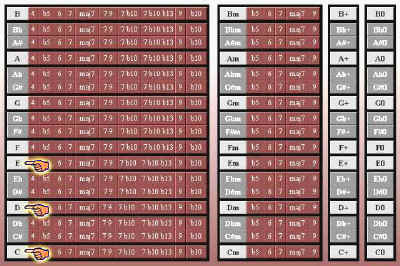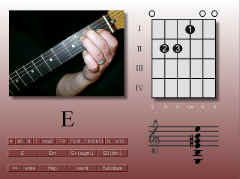WELCOME to Guitar
George
|
 |
This page consists of 4 blocks
| - Block 1 | major chords. (standard +10 additions) |
| - Block 2 | minor chords. (standard + 5 additions) |
| - Block 3 | augmented (+) chords |
| - Block 4 | diminished (0) chords |
The standard chords are ranged from foot (C) to top (B) in
chromatic order.
[ C - C# - Db - D - D# - Eb - E
- F - F# - Gb - G - G# - Ab - A
- A# - Bb - B ]
The
chords in the major and minor block are classified from left to right in numerical
order of the most used added notes:
[ majeur: standard
- 4 -
b5 - 6 - 7 - maj7 - 7 9 - 7 b10 - 7
b10 b13 - 9 - b10 ]
[ mineur: standard
- b5 - 6 - 7 - maj7 - 9
]
*) The numbers refer to the added notes in the related scale of the presented chord.
IMPORTANT
( FOOT) NOTES!
In
general not all chords will be fully named like G.G. does for you now:
- A 7-9 chord is just called 9, though there's a 7 in it
too!
- 7 b10 is called b10,
- 7 b10 b13 is abbreviated to b13,
- last but not least the b5 chord is often played with a 7!
Strenght
and lots of fun!
Guitar George
<< Return to survey | How to order >>
Information on a chord
 |
Grouping
of information:
Upper left: photo of the presented chord.
With
the buttons underneath the photo you click to another chord of the same name;
the buttons are ranged in:
a) Main groups (middle row):
[Major] - [minor] - [augmented
(+)] and [diminished (0)]
b) Subgroups (upper row)
to the major chord:
[4] - [b5] - [6] - [7] - [maj7] - [7 9] - [7 b10] - [7 b10 b13] - [9] - [b10]
to the minor chord:
[b5] - [6] - [7] - [maj7] - [9]
Other navigation options (lower row)
| [<<] : | Return to survey page. |
| [Help] : | With
the help button you'll get this very page. (At where you are now) |
| [Sound] : | Sound
of the presented chord will be audible. |
| [Substitute] : | Preference
for a certain fingering can be seen in relation to, for example, a composition, music style or arrangement. |
Up right you find the chord symbol with fingering. The
diagram is a represantation of the guitar neck.
The vertical lines represent the strings.
From
left to right: E - A - D - G - B - E
The
horizontal bars represent the positions. The Roman numbers on the left
of the bars indicate
the positions of the chord on the neck. The index finger (1) determinates
the position.
Explanation
of the symbols in the diagram:
| - X: | Don't play / Mute |
| - O: |
Open string; do play. |
| - 1: |
Index finger |
| - 2: | Middle finger |
| - 3: | Ring finger |
| - 4: |
Little finger |
The
note names of each string are represented by white characters underneath the
chord diagram.
Barre (Barred): Finger placed on the neck effecting two or more strings .
-
At the right side below the chord diagram you kan find the notes of the
represented chord.
| # : | 1 time raised by a semi tone |
| X : | 2 times raised by a semi tone |
| b : | 1 time flattened by a semi tone |
| bb : | 2 times flattened by a semi tone |
| 8va : |
Played 1 octave higher than represented. |
<<
Return to survey | How
to order
>>